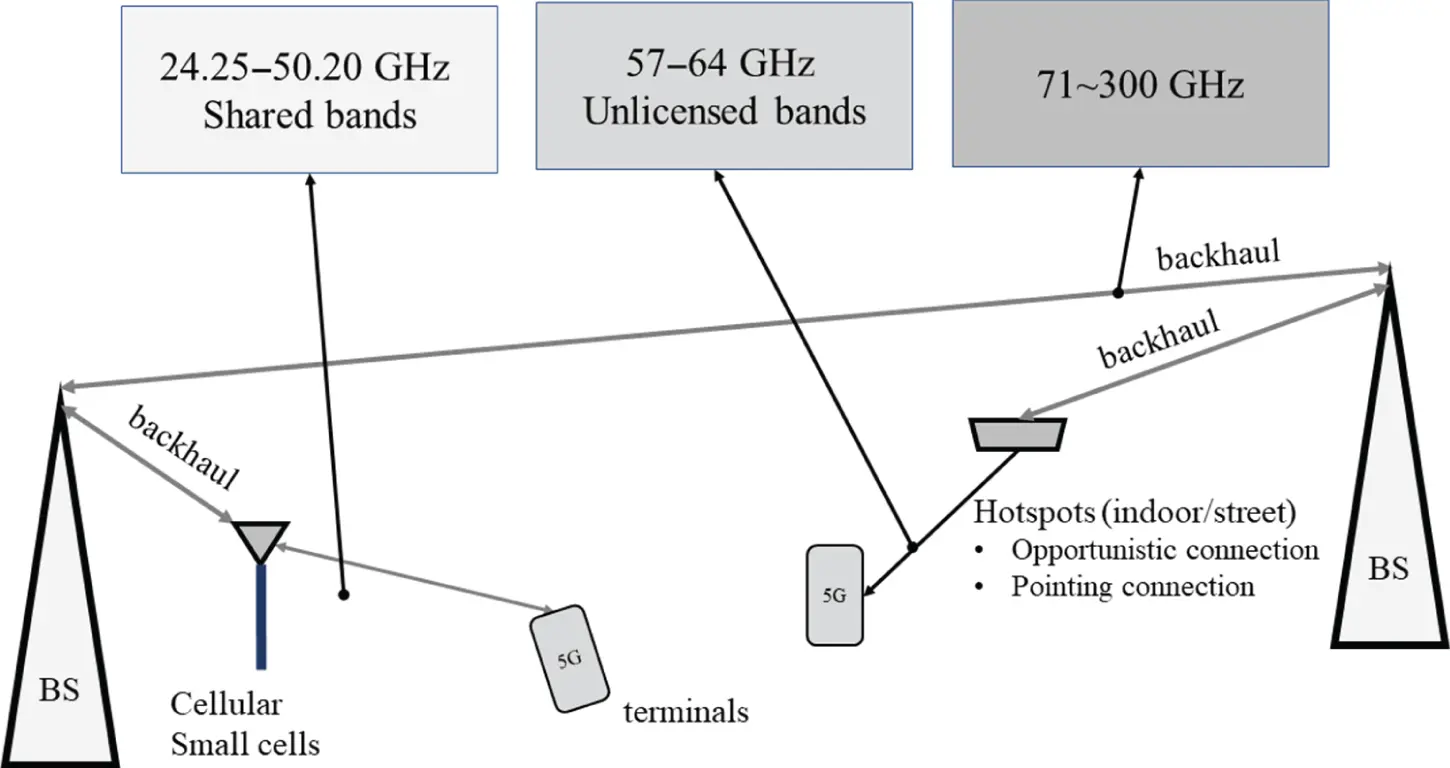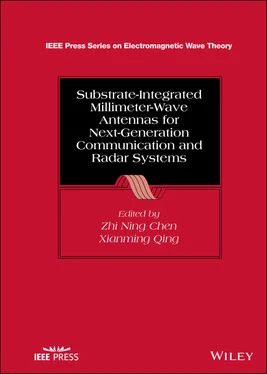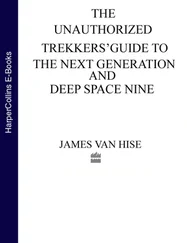Uplink (UL): base station (BS) receive and user equipment (UE) transmit
Downlink (DL): base station (BS) transmit and user equipment (UE) receive.
Table 1.6 Comparison of features of network at 5G NR sub‐6 GHz and mmW bands.
|
Sub‐6 GHz |
mmW |
| Bandwidth |
∼100 MHz |
500 MHz @28 GHz/>2 GHz @E‐band |
| BS/UE antenna configuration |
Single/sectorized arrays |
Very high‐gain directional arrays |
| Network deployment |
Low base‐station density |
Very high base‐station density |
| Small‐scale fading |
Correlated with high rank |
Correlated with low rank, varies with line‐of‐sight (LOS) or Non‐LOS (NLOS) |
| Large‐scale fading |
Distance dependent path‐loss |
Distance dependent with random blockage model and total outage |
| No of users served simultaneously |
High (>10) |
Low (<10) |
Besides the mmW frequency bands released by 3GPP for 5G NR, the extension of mmW bands from the lower edge frequencies around 30 to 60 GHz even higher has been proposed and investigated for mobile communication networks for years. However, due to even higher path‐loss and severer blocking at upper mmW bands, the mmW systems may have different applications as shown in Figure 1.11. The systems operating at 60 GHz bands may be a good option for indoor hotspots or hot‐region coverage for opportunistic connections and/or pointing connections for high data transmission. Systems operating at frequencies higher than typically 110 GHz have been used for long distance backhauls to replace higher cost optical fiber or cabled connections. The new application may be the backhauls between macro BSs and small cell BSs for low‐cost and flexible network setup.
In short, it can be foreseen that the applications of mmW systems in the 5G NR are just a start and still present many technical challenges. In the 5G and even beyond 5G, the antenna technologies will play increasingly important roles. The small or compact multiple functional massive MIMO, beamforming/scanning, multi‐beam, and reconfigurable antenna systems will be greatly developed to meet the challenging system demands.

Figure 1.11 Potential mmW applications in 5G NR and future networks.
1.9 Organization of the book
This book is organized in the following way:
Chapter 1, “Introduction to Millimeter Wave Antennas” by Zhi Ning Chen, is an introductory chapter of this book. First the relevant concepts of mmW technology are introduced. Then the unique propagation characteristics of mmW are reviewed, associated with the existing and promising applications of mmW technologies. After that, the unique design challenges of antennas at mmW bands are addressed, followed by a brief overview of state‐of‐the‐art mmW antenna designs. The last part briefly discusses the challenges in the fabrication of mmW antennas from the selection of materials to processes. The latest developments and applications of the mmW systems for 5G new radio and beyond are briefed for future research development of antenna technologies.
Chapter 2, entitled “Measurement Methods and Setups of Antennas at 60–325 GHz Bands” by Xianming Qing and Zhi Ning Chen introduces the testing setups of mmW antennas by addressing expensive testing setup, limited system dynamic range, complicated, and tedious calibration, as well as measurement procedures. This chapter deals with the measurement issues of the mmW antennas from 60 to 300 GHz. First, the state‐of‐the‐art mmW antenna measurement systems are presented. Then the key considerations of configuring the measurement systems are addressed. In the last part, the detailed setup configurations for achieving the maximum system dynamic range with the available commercial accessories are described, wherein the measurement of reflection coefficient, gain, and radiation pattern of a number of antennas at 60, 140, and 270 GHz bands with different feeding connections (coax, waveguide, and probe) are exemplified.
In Chapter 3, “Substrate Integrated mmW Antennas on LTCC” Zhi Ning Chen and Xianming Qing introduce the basic concepts of SIW antennas, in particular, SIW slot antennas. Then, design examples in LTCC are elaborated. The examples include planar high‐gain arrays operating at 60, 140, and 270 GHz. In particular, the three‐dimensional corporate feeding network is introduced by taking advantage of the LTCC process.
In Chapter 4, “Broadband Metamaterial‐Mushroom Antenna Array at 60 GHz Bands,” by Wei Liu and Zhi Ning Chen, the techniques for enhancing the bandwidth of patch antennas are reviewed first. Then, the bandwidth enhancement techniques are evaluated for substrates of high dielectric constant. In particular, the metamaterial mushroom antenna technique are introduced for the LTCC mmW antenna design due to the merits of low profile, broadband, high gain, high radiation efficiency, low mutual coupling, and low cross‐polarization levels.
Narrow‐wall‐fed Substrate integrated Cavity (SIC) Antenna at 60 GHz is discussed in Chapter 5, by Yan Zhang. This chapter addresses the unique challenges of mmW SIC antenna design. At first, the mmW cavity antennas are reviewed. Then, the selected state‐of‐the‐art SIC antennas are introduced and discussed. In particular, the technique to excite an SIC using a narrow‐wall slot is elaborated, and furthermore a 2 × 2 array with narrow‐wall‐slot fed SIW at 60 GHz is presented as an example.
Chapter 6, entitled “Cavity‐Backed SIW Slot Antennas at 60 GHz,” by Ke Gong, introduces the history and milestones of the cavity‐backed antennas (CBAs) first, together with some challenges for mmW applications. Then, the low‐profile design methods and fabrication techniques about CBAs are analyzed, especially for the substrate integrated CBAs. After that, the low‐profile SIW CBAs are reviewed. Their operating mechanisms are discussed, and methods for improving the performance, such as bandwidth enhancement, size reduction, and gain improvement, are presented. At last, a type of cavity‐backed SIW slot antennas with big‐aperture is presented as an example, with design details as a study case, including the antenna element. This type of antennas retains the advantage of conventional metallic CBAs, including high gain, high front‐to‐back ratio, and low cross‐polarization level, and also keep the advantages of the planar antenna including low profile, light weight, low fabrication cost, and easy integration with the planar circuit.
In Chapter 7, “Circularly Polarized SIW Slot LTCC Antennas at 60 GHz,” Yue Li first reviews the selected state‐of‐the‐art techniques for mmW circularly polarized (CP) antennas. Second, as a feasible example to achieve both wide impedance and axial ration (AR) bandwidths, an SIW‐fed slot antenna array with strip loading is introduced at 60 GHz using an LTCC substrate. The AR bandwidth enhancement property is systematically described with the potential adoption in various mmW CP applications.
Chapter 8, entitled “Gain Enhancement of LTCC Microstrip Patch Antenna by Suppressing Surface Waves,” by Zhi Ning Chen and Xianming Qing, introduces the technology to suppress the surface wave losses caused by the thick and high‐permittivity dielectric substrate in mmW antennas. First, the mechanism of generation of surface wave losses is discussed. Then the method to suppress the surface waves is addressed with an example of patch antenna. After that, the planar and via‐less antenna array operating at 60 GHz is exemplified for gain enhancement by suppressing the surface wave losses. The method to suppress the surface wave is to cut open‐air cavities around their radiating patches. The open‐air cavities reduce the losses caused by severe surface waves and dielectric substrate at mmW bands. The arrays are excited through either a microstrip‐line or stripline feed network with a grounded coplanar‐waveguide (GCPW) transition. The GCPW transition is designed so that the antenna can be measured with the patch array facing free space, therefore reducing the effect of the probe station on the measurement. The proposed antenna arrays with the open‐air cavities achieve gain enhancement of 1–2 dB compared with the conventional antenna array without any open‐air cavity across the impedance bandwidth of about 7 GHz at the 60 GHz band.
Читать дальше













